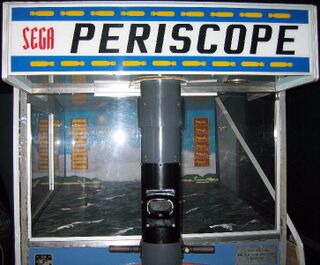Difference between revisions of "Periscope"
From Sega Retro
m |
m |
||
| Line 3: | Line 3: | ||
| publisher=[[Sega]] | | publisher=[[Sega]] | ||
| developer=[[Sega]] | | developer=[[Sega]] | ||
| − | | system={{Arcade}} Electro- | + | | system={{Arcade}} Electro-mechanical |
| players=1 | | players=1 | ||
| + | | genre= | ||
| releases={{releases | | releases={{releases | ||
| arcade_date_jp=1966 {{ref|1=[https://books.google.co.uk/books?id=DbFxAgAAQBAJ&pg=PA6 ''Service Games: The Rise and Fall of SEGA'' (page 6)]}} | | arcade_date_jp=1966 {{ref|1=[https://books.google.co.uk/books?id=DbFxAgAAQBAJ&pg=PA6 ''Service Games: The Rise and Fall of SEGA'' (page 6)]}} | ||
Revision as of 20:59, 18 June 2016
| Periscope | |||||
|---|---|---|---|---|---|
| System(s): Electro-mechanical | |||||
| Publisher: Sega | |||||
| Developer: Sega | |||||
| Number of players: 1 | |||||
|
Periscope (ペリスコープ) is a 1966 electro-mechanical arcade submarine game with the player looking through a periscope to shoot ships manufactured by Sega. Interior scenery inside the machine is lit up with a blacklight tube.
Contents
Gameplay
As the game starts boats start cruising by across the back of the scenery, and the front glass lights up "torpedoes ready to fire". Look through the periscope and aim in front of the ship, then press the fire button on the right handle. An electronic "whoosh" sounds is made as the torpedo heads towards the boat. There are a series of ten torpedo shaped lights on the playfield that make the torpedo look like it's moving towards the ship (light animation). If the boat is hit the scenery flashes a 120 volt red light from each side and an explosion is heard.
There is an electronic sound board that makes the sonor "beep" and the torpedo "woosh" sounds, and an amplifer circuit for these sounds. The explosion sound however is a mechanical sounds. It's made by pulling in a relay attached to a spring, with a magnet (to make the sound more robust) near a transducer. The spring vibrates and is read thru this phonograph needle/transducer device, like an old guitar reverb unit. A 500 mfd cap is added to the explosion relay to hold the relay in for about 2 seconds giving a longer explosion sound (if the explosion sound is too short, this cap is probably dead). This mechanical set up gives a nice explosion. The power supply for the sonar/woosh sound boards is unregulated 18 volt DC and comes from 12 volt AC to a single diode and capacitor. Adding capacitance can reduced sound hum, but will not eliminate is. It's just 1/2 wave DC regulation (not full wave like a bridge rectifier would provide), so there will always be a bit of hum.
The machine tracks how many torpedoes have been fired and how much tonnage has been sunk. The goal is to sink as many boats as you can using your torpedoes. The game gives you ten torpedoes per play with bonus torpedoes awarded for a perfect score. The boats also may change direction at any time for more challenge. There are also two windows in the front top glass that allow other people to watch the action as you play. Scoring is done with light box scoring (no score reels).
History
Development
Periscope is said to have been partially designed by David Rosen, being one of the first arcade game projects to be started by the newly formed Sega Enterprises following the merger of Rosen Enterprises and Service Games in 1965.
Legacy
A three-player version was advertised by Sega, taking the form of a large installation with three separate periscopes. This variant is exceedingly rare - only one is definitely known to have existed, being a setup used for the 14th Hotel Equipment Exhibition (where it stood at the Socodimex booth) in late 1967. Reportedly it was very popular, taking in 500 francs a day.
Sega Ages 2500 Series Vol. 26: Dynamite Deka replaces the Deep Scan mini-game in the original Dynamite Deka with a simulation of Periscope.
Specifications
- Height: 72"
- Width: 48"
- Depth: 96"



